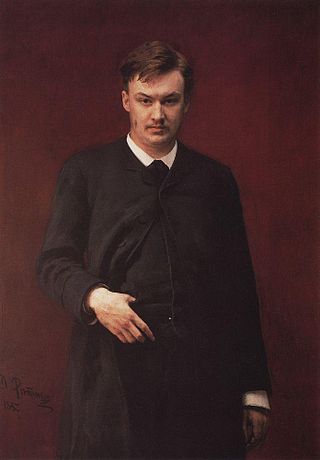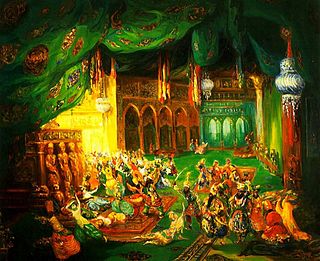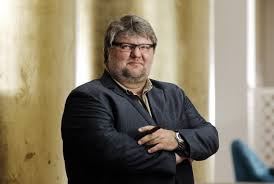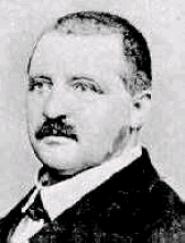Related Research Articles

Alexander Konstantinovich Glazunov was a Russian composer, music teacher, and conductor of the late Russian Romantic period. He was director of the Saint Petersburg Conservatory between 1905 and 1928 and was instrumental in the reorganization of the institute into the Petrograd Conservatory, then the Leningrad Conservatory, following the Bolshevik Revolution. He continued as head of the Conservatory until 1930, though he had left the Soviet Union in 1928 and did not return. The best-known student under his tenure during the early Soviet years was Dmitri Shostakovich.
Symphony No. 12 in D minor, Op. 112, titled The Year 1917, was composed by Dmitri Shostakovich in 1961. He dedicated it to the memory of Vladimir Lenin. Although the performance on October 1, 1961, by the Leningrad Philharmonic Orchestra conducted by Yevgeny Mravinsky was billed as the official premiere, the actual first performance took place two hours earlier that same day in Kuybyshev by the Kuybyshev State Philharmonic Orchestra conducted by Abram Stasevich.
The Symphony No. 9 in E-flat major, Op. 70, was composed by Dmitri Shostakovich in 1945. It was premiered on 3 November 1945 in Leningrad by the Leningrad Philharmonic Orchestra under Yevgeny Mravinsky.

Riccardo Chailly is an Italian conductor. He is currently music director of the Lucerne Festival Orchestra and of La Scala. Prior to this, he held chief conducting positions at the Gewandhausorchester (2005–2016); the Royal Concertgebouw Orchestra (1988–2004); the Berlin Radio Symphony Orchestra (1982–1988); and the Teatro Comunale of Bologna (1986–1993). He was also the first musical director of the Orchestra Sinfonica di Milano Giuseppe Verdi (1999–2005) and principal guest conductor of the London Philharmonic Orchestra (1983–1986).

Mariss Ivars Georgs Jansons was a Latvian conductor, best known for his interpretations of Mahler, Strauss, and Russian composers such as Tchaikovsky, Rachmaninoff, and Shostakovich. During his lifetime he was often cited as among the world's leading conductors; in a 2015 Bachtrack poll, he was ranked by music critics as the world's third best living conductor. Jansons was long associated with the Bavarian Radio Symphony Orchestra and Royal Concertgebouw Orchestra as music director.

The Suite for Variety Orchestra No. 1 is a suite in eight movements arranged by Levon Atovmyan after 1956, based on music by Dmitri Shostakovich. An editorial error in the tenth volume of the Shostakovich collected works edition published by Muzyka in 1984 resulted in the Suite for Variety Orchestra No. 1 being misidentified as the "Suite for Jazz Orchestra No. 2" or "Jazz Suite No. 2". The score was first published with the correct name in 2001.

David Geringas is a Lithuanian cellist and conductor who studied under Mstislav Rostropovich. In 1970 he won the gold medal at the International Tchaikovsky Competition. He also plays the baryton, a rare instrument associated with music of Joseph Haydn.

Scheherazade, also commonly Sheherazade, Op. 35, is a symphonic suite composed by Nikolai Rimsky-Korsakov in 1888 and based on One Thousand and One Nights.
The Moscow Philharmonic Orchestra is an orchestra based in Moscow, Russia. It was founded in 1951 by Samuil Samosud, as the Moscow Youth Orchestra for young and inexperienced musicians, acquiring its current name in 1953. It is most associated with longtime conductor Kiril Kondrashin under whom it premiered Shostakovich's Fourth and Thirteenth symphonies as well as other works. The Orchestra undertook a major tour of Japan with Kondrashin in April 1967 and CDs of the Japanese radio recordings have been made available on the Altus label.
Factory: machine-music, Op. 19, commonly referred to as the Iron Foundry, is the most well-known work by Soviet composer Alexander Mosolov and a prime example of Soviet futurist music. It was composed between 1926 and 1927 as the first movement of the ballet suite Stal ("Steel"). The remaining movements of Steel, "In Prison," "At the Ball," and "On the Square" have been lost, and Iron Foundry is performed today as a standalone orchestral episode.
Sergei Prokofiev composed and compiled his Waltz Suite, Op. 110, during the Soviet Union's post-Great Patriotic War period of 1946–1947.
Michail Vladimirovich Jurowski was a Russian conductor who worked internationally, based in Germany for most of his career. He was particularly interested in the works of Dmitri Shostakovich, in concerts and recordings.

Orchestra Sinfonica di Milano is an Italian Symphony Orchestra founded in 1993 thanks to the visionary foresight of Vladimir Delman, Marcello Abbado, and Luigi Corbani. The orchestra is based in Milan, at the Auditorium di Milano Fondazione Cariplo, located in Largo Gustav Mahler. The Music Directorate includes Riccardo Chailly, Xian Zhang, and Claus Peter Flor. Nicola Campogrande is the Composer in Residence. The new Music Director starting from the 2024/25 season is Emmanuel Tjeknavorian.
The Bolt, Op. 27, is a ballet music score written by Dmitri Shostakovich between 1930 and 1931 to a libretto by Victor Smirnov. The humorous and satirical full-length ballet in three acts and seven scenes was choreographed by Fyodor Lopukhov and premiered on 8 April 1931 at the State Academic Theatre of Opera and Ballet in Leningrad. It was not performed again until 2005, when a two-act choreography by Alexei Ratmansky was performed at the Bolshoi Theatre in Moscow.

The Moscow City Symphony was established in 2000 by the Moscow City Government. It is resident orchestra at the Moscow International House of Music. The principal conductors: Alexander Vedernikov, Maxim Fedotov, Dmitri Jurowski, Fabio Mastrangelo.

Gabala International Music Festival is an annual festival of classical music held every summer beginning in 2009 in Gabala, Azerbaijan. The festival is organised with the support of Heydar Aliyev Foundation at the initiative of the rector of the Baku Academy of Music Farhad Badalbeyli and conductor Dmitri Yablonski. At this festival, musicians perform in the open air. Participants have included musicians from Europe, the US and Israel, as well as musicians from republics of the former USSR. In 2009, a contest of young pianists was held at the same time with the musical festival. Jazz and mugham evenings were held along with classical music concerts. In 2010, the festival was held on August. General director of UNESCO Irina Bokova was in the opening ceremony of the festival. The festival began with the performance of overture from Uzeyir Hajibeyov's "Koroglu" opera as in 2009. Opening ceremony of the festival was charged to Royal Philharmonic Orchestra. Such musicians as Dmitri Yablonski, Yuri Bashmet, Khloe Khanslip and other Azerbaijani and foreign musicians took part in the festival. In 2011, the festival lasted from July 15 to August 5.

Dmitry Albertovich Yablonsky is a Russian classical cellist and conductor, who was educated at the Juilliard School of Music and Yale University.
Gara Garayev's Symphony No. 3 was composed in 1964. It was the last of the composer's three numbered symphonies and it marks a development from his two previous contributions to the genre, composed in the mid-1940s during his studies in the Leningrad Conservatory under Dmitri Shostakovich. It was one of the first serial symphonies composed in the Soviet Union, fusing the twelve-tone technique with Azerbaijani folk music influences in the ashug tradition in the frame of a classical structure, attempting to find to new ways of artistic expression, new principles of form and construction, and, most notably, new means of expressive musical language and wanting to prove that strictly following the twelve-tone technique it is possible to write nationalistic music, and not simply nationalistic, but specifically ashug according to the composer.

The Symphony in D minor, WAB 100, was composed by Anton Bruckner in 1869 between Symphony No. 1 (1866) and Symphony No. 2 (1872). In 1895 Bruckner declared that this symphony "gilt nicht" and he did not assign a number to it. The work was published and premiered in 1924.

The Five Fragments, Op. 42 is a suite for small orchestra composed on June 9, 1935, by Dmitri Shostakovich. It was the only work, apart from film music, that he composed that year. He approached it as preparatory work for the composition of the final version of his Symphony No. 4.
References
- 1 2 Dave Kopplin. "Jazz Suite No. 1". Hollywood Bowl. On the occasion of the work's first performance by the Los Angeles Philharmonic, conducted by Gustavo Dudamel in March 2011.
- 1 2 Alex Burns (22 January 2020). "Dmitri Shostakovich: Jazz Suite No. 1". classicalexburns.com.
- ↑ Richard Whitehouse (2004). Shostakovich: Ballet Suits Nos. 1–4 (PDF) (Liner notes). Russian Philharmonic Orchestra, Dmitry Yablonsky. Naxos. 8.557208.
- ↑ "Lightweight fare from Shostakovich done by a suitably characterful Russian band", Gramophone , August 2002